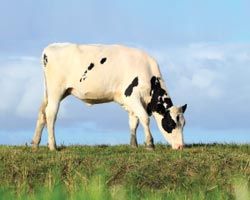The health benefits of pasture-raised foods
by Nick Rose, M.S., PCC Nutrition Educator
This article was originally published in June 2012

Most cattle operations start out feeding cows a diet of grass (also referred to as pasture), but then the cattle are switched to a grain-based diet consisting mainly of corn for at least three to six months to fatten them up prior to slaughter. It turns out that this practice of feeding grains to cattle causes their meat to be higher in fat, makes the animals more likely to get sick, and pumps more greenhouse gases into the environment than if they had stuck to their all-grass diet. Luckily, we are seeing more producers offering grass-finished meats so that we have better options for our health, the health of the animals, and the planet.
Grass-finished meats (such as beef and lamb) typically are leaner than grain-fed meats and contain much higher-quality fats. Grass-finished meats also offer:
- Higher levels of omega-3 fatty acids and a healthier ratio of omega-3 to omega-6 fatty acids than grain-fed meats. While humans are unable to digest grass to extract those beneficial omega-3s, ruminants like cows have no trouble at all obtaining those benefits (and passing them along) when allowed to feed on pasture.
- CLA, or conjugated linoleic acid, a unique fatty acid that seems to provide a wide range of benefits including a reduced cancer risk and improved cardiovascular outcomes
- More vitamin E, beta-carotene, and B-vitamins than grain-fed meats
A diet of grass also benefits dairy. One of the many benefits of choosing organic milk is that the cows must have pasture access; USDA organic standards require that organic dairy cows get a third of their diet from grasses rather than grains. It shouldn’t come as a surprise then that organic milk contains less saturated fat and more omega-3 fatty acids than non-organic milk, simply due to that pasture access. Pure Éire Dairy in central Washington supplies PCC with organic milk that comes from 100 percent grass-fed cows. Their milk offers the highest levels of CLA and omega-3s because no grains ever are fed to these cows. Who knew that grass was so nutritious!
